An impression of Documenta Fifteen
How to characterize Documenta Fifteen? A story of a hundred-day contemporary art exhibition and events that has gravitated to a much more political spectrum since its inception. Created in 1955, its first four editions had members who served in the Nazi Party or the SS as the organizers.
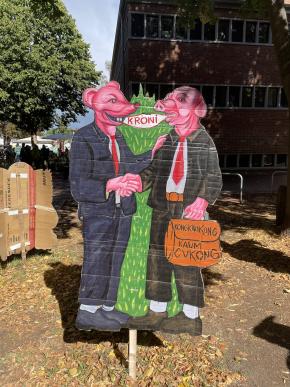 One of many 'wayang kardus' ('cardboard puppets' in Indonesian) by the Taring Padi group at the former pool Hallenbad OstAlways identified with audacity, - or, as seen in the international press, marked with “controversies” and even “scandals” - the event is among the largest and most important in the art world. The fifteenth edition that was recently carried out was not exempt from a “scandal”: the unanimity of the German press in its judgment of anti-Semitism.
One of many 'wayang kardus' ('cardboard puppets' in Indonesian) by the Taring Padi group at the former pool Hallenbad OstAlways identified with audacity, - or, as seen in the international press, marked with “controversies” and even “scandals” - the event is among the largest and most important in the art world. The fifteenth edition that was recently carried out was not exempt from a “scandal”: the unanimity of the German press in its judgment of anti-Semitism.
“The mural, originally exhibited in 2002 in Australia, features a soldierlike figure depicted as a pig and wearing a helmet bearing the word ‘Mossad’ — the name of Israel’s national intelligence agency. Another figure is depicted with the sidelocks associated with Orthodox Jews, fangs and bloodshot eyes, and wearing a black hat with a SS insignia,” Australian journalist Stuart Braun described on Deutsche Welle in June.
Two weeks after the article in question was translated into Portuguese, Bianca Hauda, moderator of the program “Twist” on Franco-German television ARTE (German program dubbed into French), did not spare criticism with heavy words: “Ein großes Desaster und eine Katastrophe mit Ansage” (A great disaster and a catastrophe with warning).
Yet despite the “scandals” that it tends to be entangled with, may we highlight, in a slightly positive light, the diversity that is showcased as Macau has occasionally appeared at this biggest art event in the world. The Dutch architect Rem Koolhaas gave a presentation on the Pearl River Delta in the tenth edition of “documenta X” in 1997, when Macau was “still Portuguese” and “with different nature and character.” Macau, along with the two other territories in this “triangle” (namely Hong Kong and Canton), were presented as the “Weltbesten Platz für Business” (The best place in the world for business).
In 2012, Macau’s Art For All Society (AFA) promoted, on the occasion of its fifth anniversary, a lecture entitled “Kassel’s 128 Hours” with local artist and art educator Allen Wong sharing his experience of visiting “dOCUMENTA (13),” the thirteenth edition of the German quinquennial. This edition featured the participation of the Macau-born artist and former student of Colégio de Santa Rosa de Lima, Cecilia Ho, in the group exhibition “LOUD: Mapping the Aesthetics of Visual Silence,” representing, however, Hong Kong.
Again, what’s art?
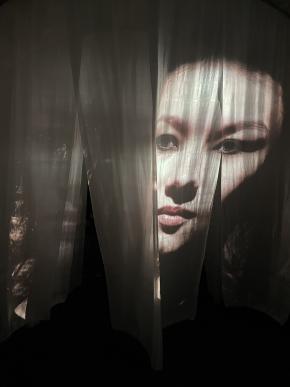 Artwork by Uzbek filmmaker Saodat Ismailova and the Central Asian collective DAVRA, at FridericianumWhat Documenta touches me the most, however, is the discussion that it raises around the question of what an artist is.
Artwork by Uzbek filmmaker Saodat Ismailova and the Central Asian collective DAVRA, at FridericianumWhat Documenta touches me the most, however, is the discussion that it raises around the question of what an artist is.
In his legendary interview with the Belgian singer and actor, Jacques Brel (1929-1978), during the Cannes Film Festival in 1973, the great French journalist Jacques Chancel (1928-2014) intended to indicate “various categories of singers.” The answer of the Belgian legend is, today, a set of phrases that are often cited in the French language when talking about what it is to be an artist. One of them is:
“Je crois qu’un artiste, c’est quelqu’un qui a mal aux autres.” (I believe that an artist is someone who feels pain with others.)
The Brelian poetics of “an artist” in which “it hurts” by being “with the others” sometimes brings me to tears. A certain hierarchy of concepts mixed with many life experiences brings me, however, to question whether this issue is genuine or merely instrumentalized or even institutionalized. It was with this problem in mind, and with the label and position of “Künstler” (“artist” in German) that was authorized by the Berlin’s Authority of Foreigners, that I went to consume art at Documenta.
I arrived, with the Polish artists Marta and Katarzyna Sala, on a late September morning at Kassel Central Station. As I passed along Treppenstrasse, the first German pedestrian street built in the 1950s, the ramp strangely reminded me of Rua dos Ferradores in Chaves, Portugal. With three friends, we went to the Fridericianum Museum, one of the first public museums in the world and the main location for Documenta. A German diplomat, a French filmmaker and a German-Bulgarian sinologist whose mother lived in pre-War Berlin were waiting for us.
In August, in my tiny studio in the south of Berlin, I hosted Yipei Lee, who curated the project and an exhibition at Documenta, “Terracotta Embassy Activation: Wagiwagi – Meeting Art and Ecology.” She was in Berlin for an artistic research project. Even after several intensive conversations about its curatorship, and retaining the experience of seeing too many films in the various editions of the Berlinale, I did not believe that Documenta would have an emotional impact on me. I imagined something more towards the genre of “another large-scale institutional event.” “Anti-Semitism” or “politics” were reduced to journalistic themes, but criticism was not effusive. Even many of the country’s culture journalists seemed unenthusiastic about the event.
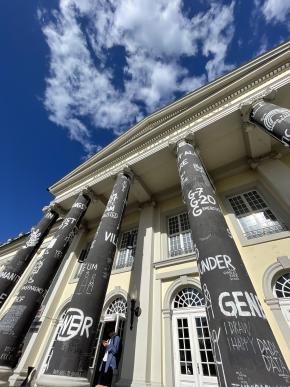 Fridericianum Museum, one of the first public museums in the world and one of Documenta’s main locations
Fridericianum Museum, one of the first public museums in the world and one of Documenta’s main locations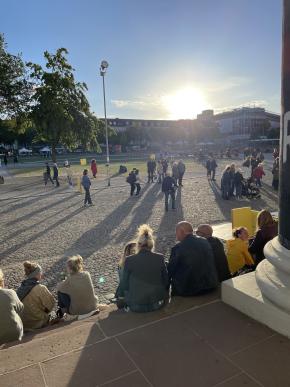 Friedrichsplatz, in front of the Fridericianum
Friedrichsplatz, in front of the Fridericianum
I noticed an article Yipei Lee shared in June by Carola Padtberg, a Germanist by training, in the main Spiegel magazine. The first words read “Die Werke wirken flach” (The works look futile). When the electronic version of the article’s title changed the text to “gibt es wenig zu sehen” (there is no much to see), the overwhelming majority of the German press focused on the judged anti-Semitism at this world exhibition, an exhibition that costs more than 42 million euros.
At the Fridericianum, the exhibition by the Asia Art Archive (AAA) was the first thing that caught my attention: several people participating had already exhibited in Macau.
Arahmaiani, artist from Indonesia, exhibited at ARTFEM Women Artists International Biennial of Macau. Ko Siu Lan, from Hong Kong, performed at the first edition of the Macau International Performing Arts Festival in 2005. Ma Liuming, from Mainland China, and Lee Wan, from Singapore, have already performed in the “Inner Looks” exhibition series of Macao Museum of Art curated by Noah Ng, in 2005 and 2008, respectively.
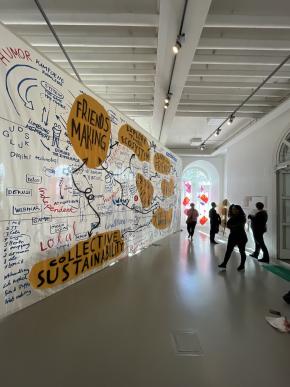 Mindmap by the Rojava Cinema Commune, a collective of Kurdish filmmakers from northern Syria
Mindmap by the Rojava Cinema Commune, a collective of Kurdish filmmakers from northern Syria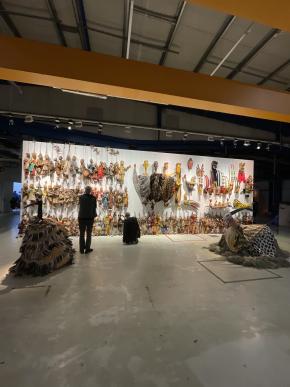 'Wall of puppets,' by Malian artist Yaya Coulibaly, presented as part of the exhibition of the Fondation Festival sur le Niger at Hübner Areal
'Wall of puppets,' by Malian artist Yaya Coulibaly, presented as part of the exhibition of the Fondation Festival sur le Niger at Hübner Areal
“Chill,” I told myself. After a brief excitement of seeing the toys made by Indian artists KG Subramanyan (1924-2016) and Feroz Katpitia (1926-1998) beautifully presented at the AAA exhibition at Fridericianum, all I wanted was to stay and watch the films presented at the event.
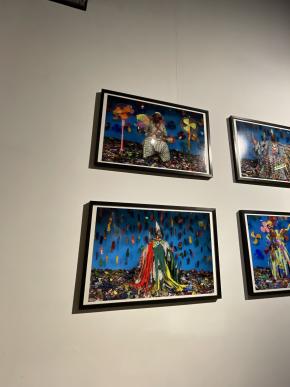 Seydou Camara’s photographs at Hübner Areal are 'so beautiful that make me cry,' Polish artist Marta Stanisława Sala saysThe themes were heavy. The Black Archives (Netherlands) presented an exhibition of documentation about a dark page in colonial and racist European history with an old television documentary in a VHS-like format. The names of the Archives des luttes des femmes en Algérie – which is, by the way, another group of participating artists and activists deemed anti-Semitic – or the Center d’art Waza (Democratic Republic of Congo) in itself says a lot. Along with the visual works of Komîna Fîlm a Rojava (Rojava Film Commune in Kurdish), a group of filmmakers from northern Syria or the Uzbek filmmaker Saodat Ismailova and her Central Asian collective “DAVRA.” I saw all of the movies and videos on Fridericianum, formerly “Palast der Stände” of Jérôme Bonaparte, Napoleon’s brother.
Seydou Camara’s photographs at Hübner Areal are 'so beautiful that make me cry,' Polish artist Marta Stanisława Sala saysThe themes were heavy. The Black Archives (Netherlands) presented an exhibition of documentation about a dark page in colonial and racist European history with an old television documentary in a VHS-like format. The names of the Archives des luttes des femmes en Algérie – which is, by the way, another group of participating artists and activists deemed anti-Semitic – or the Center d’art Waza (Democratic Republic of Congo) in itself says a lot. Along with the visual works of Komîna Fîlm a Rojava (Rojava Film Commune in Kurdish), a group of filmmakers from northern Syria or the Uzbek filmmaker Saodat Ismailova and her Central Asian collective “DAVRA.” I saw all of the movies and videos on Fridericianum, formerly “Palast der Stände” of Jérôme Bonaparte, Napoleon’s brother.
That was how I spent a quarter of my very short stay in Kassel, the twin city of Ramat Gan (near Tel Aviv) or Yaroslavl (250 kilometers from Moscow). At Friedrichsplatz, or Praça de Frederico - the main square in front of the Fridericianum that was severely bombed by the Allies in 1941 and 1943 -, reigned a sunny afternoon with a cool late summer wind.
There was not only “anti-Semitism”
The square named after Frederick II of Hesse-Kassel was less crowded than I had imagined. It was after this trip that I noticed that the entire work of “People’s Justice” had been removed.
Conceived in 1768, the Praça de Frederico today possesses the “7000 Oaks” (1982), a work of art by one of the most prominent German artists after the Second World War and antagonist of Andy Warhol (1928-1987), Joseph Beuys (1921-1986).
This was how my first Documenta journey ended at the Fridericianum and the Ottoneum, that is, the Naturkundemuseum or Museum of Natural History. “It’s absurd,” said my German diplomat friend, “that German names are Latinized in this way”.
Contrary to what Padtberg wrote “that there is little to see,” I was overwhelmed on the first day of the event. For, if art is not seen in Kassel from an orthodox point of view, Brel was right about what art is: “Talent is having the will to do something.”
I slept till late on my second day in Kassel. I went with Marta Stanisława Sala to see the Documenta Halle, Rondell – etymologically equivalent to the Portuguese word “arandela” or “rondelle” in English and which is a fort built in 1523, with great resemblance to our S. Francis Barracks in Macau. There, in the dark space of the fort, I saw the beautiful audiovisual installation, “And They Die a Natural Death,” by a well-known Vietnamese artist Nguyễn Trinh Thi who was kind enough to include an old film of mine in the frame of the Hanoi DocFest, in 2017, in Hong Kong.
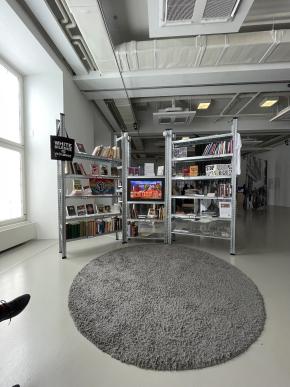 The Black Archives’ library at Fridericianum
The Black Archives’ library at Fridericianum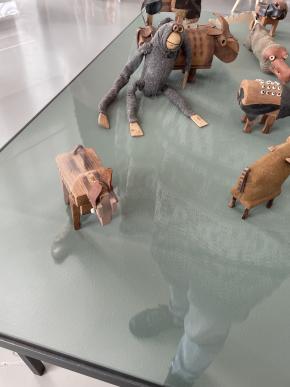 Toys made by Indian artists KG Subramanyan (1924-2016) and Feroz Katpitia (1926-1998), displayed at the Asia Art Archive exhibition at the Fridericianum
Toys made by Indian artists KG Subramanyan (1924-2016) and Feroz Katpitia (1926-1998), displayed at the Asia Art Archive exhibition at the Fridericianum
But it was the last hours that marked the most emotional for me on this very brief trip to the German state of Hesse. We went to see many dozens of “wayang kardus” (“cardboard puppets” in Indonesian) from Taring Padi, a group of students and activists founded in 1998 in Indonesia as a reaction to “socio-political upheavals” in the country, according to the organizer. Many of these puppets are represented with an aesthetic coherence marked by their strong colors and many of them have a pig’s head.
The theme surrounding the judged anti-Semitism and the form of organization at Documenta is infinite. And above all, this topic is not emotionally neutral in Germany. Conversations with Gudrun Ingratubun, an artist from Berlin who engaged herself as an educator at Documenta, and one of her Indonesian collaborators who is part of the puppet painters in question, however, enabled me to understand quite differently than the speech against the anti-Semitism as it is judged so and the ubiquitous severe criticism of Documenta. Equally enlightening were the intense dialogues with a group of Polish artists in Cologne or, back in Berlin, with the German artist Johanna Reichhart, or the reading of Hanno Hauenstein’s articles in Berliner Zeitung, a newspaper with the name of the German capital.
What Documenta has offered is proof that art can be much more than one imagines. As for the scandals – I finally write without parentheses, that I am curious to see how in the future Germany itself and the rest of the world, or rather the worlds, will see this Documenta Fifteen retrospectively.
Photos by Cheong Kin Man
The article was originally published in Portuguese in Jornal Tribuna de Macau on 25 October 2022. The author thanks Jennifer Liu for the kind suggestions to improve the text in English while nevertheless assuming the whole responsibility.